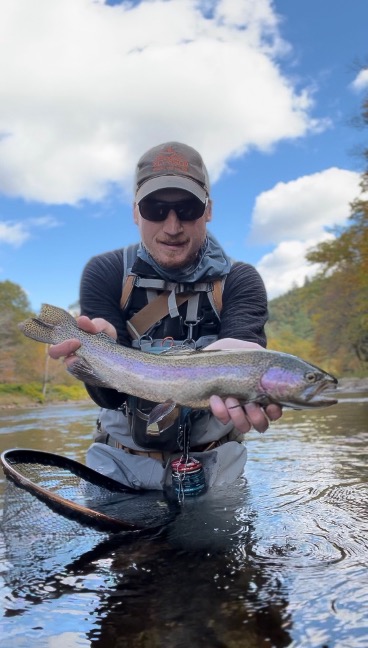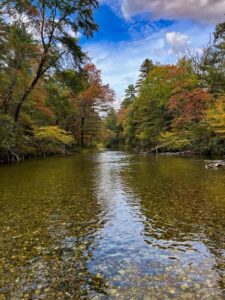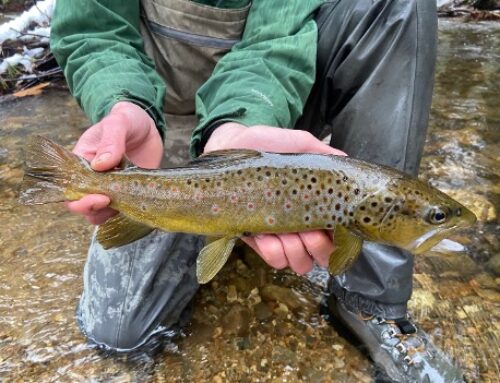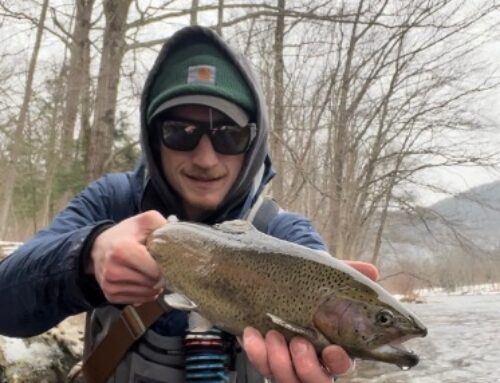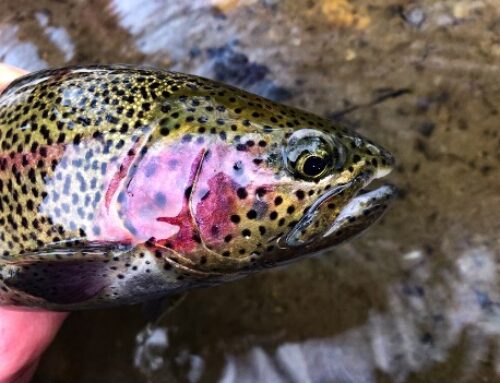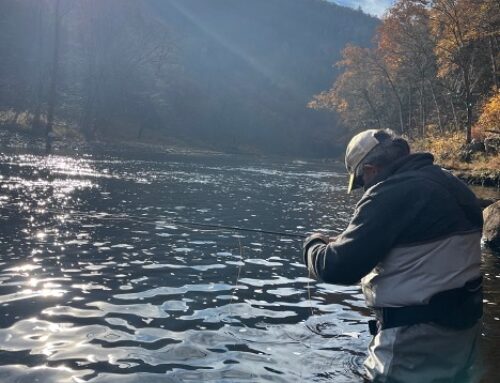Fall has officially arrived and the evidence is painted across the changing leaves. This time of year is marked by significant fluctuation across the fishery which yields both benefits and challenges in relatively equal measure.
On the Deerfield and beyond, water temperatures should maintain low enough that you can likely put the thermometer away for the season. As this report is being written, the D is pulling around 60° on low, midday flows. With significantly cooler air temperatures on the horizon—especially overnight—cold flows should only be getting colder, despite a continued lack of rain.
Things have changed a lot in a short amount of time on the Deerfield which is pretty typical for this time of year. Only in the past week or so have fish begun to shift sights away from surface forage in significant measure. There are still some fish around willing to take a shot up top, but those numbers are dwindling. So long as overnights remain above freezing there should still be some terrestrials around like hoppers and ants, but that window will slam shut soon. The first freezing overnights and the frost that they bring will put terrestrial bugs away for good. While the window of opportunity still remains slightly open, you can never go wrong with a chubby and a dropper or a para-ant but be wary about forcing the issue.
As for traditional hatches, there are still some small tan caddis around—usually in sizes #18-20—but again, you might find yourself doing some significant searching for fish willing to take a dry imitation. The same can also be said for blue winged olives (#20-22) which continue to hatch without much harassment on the surface. If you do luck into some risers, an elk hair or CDC caddis is a good choice for the former, and a small parachute or CDC/poly-wing emerger will work well for the latter.
The big-ticket item as far as hatch goes, however, is the arrival of the October caddis or great autumn brown sedge. These big (#8-12), orangey caddisflies have an interesting lifecycle, swimming as pupa to areas of slow water before crawling onto rocks and taking off as adults, usually later in the day. The females then return during low light periods to deposit their eggs back into the water. If you’re lucky enough to find some risers with Octobers around, a Goddard caddis casted in close proximity to stable rock structure—both on the bank and in the river’s channel—is a smart choice. Keep in mind, though, that fish often have a limited window to get at Octobers on the surface and will often key in on them more in the subsurface where they are still emerging. Our October caddis pupa is great option in such circumstances and is fished well both swung and dead drifted.
Perhaps best of all is the quickly improving fall streamer season. This is the time of year when many trout begin moving around in search of high value forage. Brown trout, especially wild fish, in particular are known to hunt aggressively during their pre-spawn period in the early to mid-fall. Large fish that usually relate to heavy structure and more or less hide under daylight for much the year become significantly more active as they prepare for the trials of both spawning and winter. For more on streamer fishing, check out our new blog post here.
As for the Westfield and Millers Rivers, the situation on each is pretty drastically different from the other. The Millers is running a bit low but has just been stocked recently so there’s definitely plenty of fish around. New stockies tend to group together in the nearest stable depth to their drop point and will usually remain bunched up for a week or so before distributing wider across the river. Remember that freshly stocked fish aren’t conditioned to feeding naturally yet so fly selection is not of much importance. Stick with eggs (which do double duty as a hatchery pellet imitation) and small streamers, both of which are often chased down aggressively by curious new stockies. This same principle will also be true on the Deerfield which has been fully stocked. This pattern will continue to be effective even after stocked fish have been conditioned to feed naturally as eggs become major forage during the spawn and small streamers work well in most situations. The Westfield, on the other hand, is a much different situation. Flows are very low owing to a significant lack of rain and it appears there are no plans to stock it this fall according to the state’s website. You might luck into a holdover here and there, but the Westfield is certainly not the first place we’d send you right now.
On the Swift River, flows continue to be a bit higher than average with the river running around 130 CFS as this report is being written. The Swift also received a fresh stock of trout recently, however, numbers are relatively sparse throughout much of the river. Many of the new stockies are very bunched up in wood structure on the river’s margins and of course at the Y-Pool and hatchery pipe. In terms of pattern for the new fish, what’s been said previously will remain true here: eggs and small streamers until you have a reason to change up. Thinking more about holdover and wild trout, there are still some good opportunities to cast at fish rising to both midges (#26-30) and BWOs (#20-24). For midge imitation, you can never go wrong with Dan Trela’s wicked pissah and on the BWO side of things, small parachutes and CDC/poly-wing emergers are always a good bet.
The big question on the Swift, though, is the fast-approaching brook trout spawn. Significantly increased numbers of brookies have been observed in popular spawning areas like the fly-only section and the gravel banks around Cady Lane. Many of these fish are still pre-spawn and have the feed bag on, presenting excellent opportunities especially on the surface; however, there are a few fish out there already digging redds. A cursory reminder to always leave spawning trout to their business. Be mindful of where you’re wading to avoid stepping on redds and never cast to spawning fish. It cannot be understated how fortunate we are to have access to fisheries that offer such prolific wild reproduction and it’s absolutely essential to fish fairly during the spawn. This being said, some serious opportunities can be had during the spawn as many big rainbows and browns file in behind chains of redds to gorge themselves on egg forage. When fishing to egg eaters, be extraordinarily careful not to cast over the redds themselves and know that there are some circumstances where you might need to just move on as the brookie spawn tends to take up a lot of the river’s real estate.
As for local small water, the creeks continue to be at minimal flows owing to a significant lack of rain over the last couple months. This fact has many creek fish grouped up in their respective system’s most stable depth and has left them pretty skittish. This isn’t to say that the creek’s aren’t targetable at the moment but do be wary about putting too much stress on fish, especially as wild individuals do their best to prepare for the upcoming spawn. If you do decide to head out for a bit of small water fishing, it will likely be best to focus attention on pools and plunges rather than riffles and runs which will generally be too skinny to hold fish given the current flow situation. Play around with presentation too; although the dry fly window is swiftly closing, you might still find a few fish willing to look up here and there. With some bugs still around, consider dropping a nymph off a dry fly if you’re not finding success at the surface. Also, on the note of spawning, the same rules mentioned for the Swift and elsewhere will apply equally to the creeks. Be very mindful of where you’re wading and never cast to actively spawning fish.
Beyond trout, the “warm” water fishery also has a lot to offer at this time of year while many fish have the feed bag on in preparation for colder weather. The Connecticut River presents some excellent opportunities for both bass and pike in the fall although it is running notably low at the moment (2000 CFS as this report is being written). While the low water can make things a bit tough, the silver lining is that navigating the banks on foot becomes significantly easier. It also aids in identifying fish-holding structure that might otherwise be submerged, so take note of grass, wood, and rock where you can. With some rain on the horizon, hopefully we should see more productive flows on the big river soon.
As for still water fishing, this past week has seen some giant pike come to hand out of local lakes. Many local pike fisheries both still and moving water are tough to dial on foot, but again, low water levels have made things a bit more approachable. If you’ve got a way to float—outboard, kayak, paddleboard, what have you—now is the time to get out and start prowling some grass lines and drop-offs. On the bass side of things, keep in mind that both largies and smallies often hunt shallow water at this time of year aiming to crash and entrap bait against the banks. Streamers are always a good option but don’t be afraid to give a topwater bug a try. So long as temps remain above freezing there should still be some fish out there willing to take a shot at the surface. All this being said, this time of year is highlighted by significant fluctuation both in conditions and fish behavior. Keep an open mind while plying local warm water and do your best to build off both success and failure.
Off the water, keep eyes peeled for our October blog post which will cover the wide world of streamer fishing. If you’ve got an idea for a blog submission, shoot us an email or DM with a brief description of the topic you’re interested in covering; we’d love to hear from you! Additionally, the return of Bugs & Beers is drawing close so keep an eye out for more information on that.
As always, thank you for your continued support from all of us at the Deerfield Fly Shop. We hope to see you in the shop soon and wish you luck next time you’re on the water.


